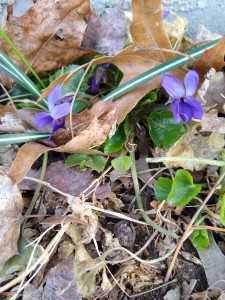 At this time of the year we celebrate spring by rushing out to the garden centers and buying flats of pansies and violas. We breathe the warming air and fill up our window boxes, pots and borders with these spring avatars.
At this time of the year we celebrate spring by rushing out to the garden centers and buying flats of pansies and violas. We breathe the warming air and fill up our window boxes, pots and borders with these spring avatars.
And then we turn around and try to exterminate their cousins, the common violets, when they pop up in our lawns.
The most plentiful wild violet in my part of the world is Viola sororia, also known as the dooryard violet, woolly blue violet and sister violet. The Latin species name, “sororia” comes from the same root as the English word, “sorority”. Everyone has seen these little plants, but few people look at them closely. Those who do, see the “woolly”, or slightly hairy, heart-shaped leaves and the characteristic violet flowers on slender leafless stalks. The blooms are generally purple to blue-purple, but common violets also appear with white flowers. The ‘Freckles’ variety features white petals splashed with small pinpoints of purple. Another common variant is Viola sororia f. priceana, in the past sometimes known as the “Confederate violet”. This nickname does not spring from any horticultural secessionist sympathies, but from the fact that the flowers are blue and grayish white, supposedly echoing the blue and gray of the Confederate uniform. Absent all considerations about the origins of the nickname, they are lovely violets.
In my garden, the violets are neither encouraged nor rooted out like scourges of humanity. They are mostly left to their own devices. Growing in profusion in the raised bed next to my garage, the purple violets are often the first flowers to open there, sometimes even ahead of the snowdrops. In that space they have recently survived the dainty feet of the painters, who tend to flatten anything in their path. The violets are blooming now and seem unaffected by last year’s painting adventure.
Not all of my common violets bloom at once. The dark blue-purple ones appear first, followed eventually by white-flowered violets and the freckled types. The latter are a mystery, because the violets that I transplanted from a friend’s yard were the priceana form. When they appeared the following year, the petals had freckles, rather than purple-blue centers surrounded by cream edges. It must be something about my soil, a genetic reversion, or some other mystery. I like the freckles, but long for the Confederates. Maybe this year I’ll try transplanting additional blue and white ones in a different spot.
So why do people disdain, if not dislike common violets? They are certainly better looking than other plants that fall into the “weed” category, like onion grass, chickweed and crabgrass,. They do tend to interrupt otherwise pristine swatches of greensward and this disturbs turf grass purists. Violets are also vigorous and sprout from underground rhizomatous roots, which means that they spread to their hearts’ content. I find that they are easy to root out when they overpopulate, but some people don’t want the rampant spreading to happen in the first place.
I am not a turf grass fanatic and prefer the “flowery mead” look of a lawn that sports violets, clover and random patches of ajuga. That kind of lawn is just as easy to walk, play and picnic on, but it is less susceptible to drought and other turf grass troubles.
However, every person has a right to decide the violet question according to his or her own preferences.
Violets of all sorts are the stuff of history, lore and legend. The flowers and leaves are edible and crystallized violets are sometimes used to decorate cakes and pastries. At various times decoctions of violet parts, possibly even the roots, have been used to treat ailments including colds, headaches and even constipation. Four states—Illinois, Rhode Island, Wisconsin and New Jersey—have adopted Viola sororia as their state flower.
Violets are the ultimate flower of spring, liking the moisture characteristic of the time around the vernal solstice. The plants thrive at the edges of woodland areas and suburban backyards. If you don’t have them in your yard and want them, check out your neighbors’ properties. Someone will have violets and will probably let you take a few. They do not mind being transplanted and will take root almost immediately. There is really nothing easier. and that is a bonus in the busiest season of the gardening year.
